Recent Posts
Essential Fire Safety Tips for Residential Homes in Sandy, UT
7/22/2024 (Permalink)
 Key Fire Safety Tips for Homes in Sandy, UT
Key Fire Safety Tips for Homes in Sandy, UT
Fire safety is a critical concern for homeowners everywhere, including those in Sandy, UT. Taking proactive measures to prevent fires and knowing how to react in case of a fire can save lives and property. Here are some comprehensive fire safety tips tailored for residents of Sandy, UT:
1. Install Smoke Alarms
Smoke alarms are your first line of defense against fires. Install smoke alarms on every level of your home, including inside bedrooms and near sleeping areas. Test them monthly and replace batteries at least once a year. Consider upgrading to interconnected alarms so that when one sounds, they all sound.
2. Have a Fire Escape Plan
Create a fire escape plan with your family and practice it regularly. Identify two ways out of every room, especially bedrooms. Designate a meeting place outside the home where everyone will gather after escaping a fire. Ensure that everyone knows how to call 911 or the local emergency number.
3. Install Carbon Monoxide Detectors
Carbon monoxide (CO) is an odorless, colorless gas that can be deadly. Install CO detectors near sleeping areas and on every level of your home, especially near fuel-burning appliances. Test them monthly and replace batteries as needed.
4. Maintain Heating Equipment
Ensure that all heating equipment, including furnaces, chimneys, and space heaters, are professionally inspected and maintained annually. Keep flammable materials, such as curtains and furniture, away from heat sources.
5. Practice Safe Cooking Habits
Cooking is a leading cause of home fires. Never leave cooking food unattended, especially when frying or broiling. Keep flammable items away from the stove, and ensure that pot handles are turned inward to prevent accidental spills.
6. Use Electrical Appliances Safely
Inspect electrical cords for damage or fraying, and replace any that are worn out. Avoid overloading outlets or using extension cords as permanent wiring. Unplug small appliances when not in use and teach children not to play with electrical cords or outlets.
7. Store Flammable Materials Properly
Keep flammable liquids, such as gasoline, propane, and paint thinner, in approved containers and store them away from heat sources and living areas. Dispose of oily rags in metal containers with tight-fitting lids.
8. Be Cautious with Candles and Smoking
Keep candles in sturdy holders on a stable surface, away from flammable materials and out of reach of children and pets. Extinguish candles before leaving a room or going to bed. If you smoke, do so outside, and use deep ashtrays filled with sand to extinguish cigarette butts.
9. Maintain a Fire Extinguisher
Keep a fire extinguisher in the kitchen, garage, and any other areas prone to fires. Learn how to use it properly and ensure it is regularly inspected and recharged by a professional.
10. Secure Your Home Against Wildfires
Living in Sandy, UT, means being prepared for potential wildfires. Create defensible space around your home by clearing debris and vegetation. Use fire-resistant materials for roofing and siding. Have an evacuation plan in place in case of a wildfire threat.
11. Educate Your Family
Educate everyone in your household about fire safety practices. Teach children to recognize the sound of smoke alarms and what to do if they hear one. Discuss the importance of fire safety and regularly review your family's fire escape plan.
12. Consider Home Security Systems
Some home security systems offer fire detection capabilities. Consider installing one that can alert emergency services in case of a fire, even when you're not home.
By implementing these fire safety tips tailored for residential homes in Sandy, UT, you can significantly reduce the risk of fire and protect your loved ones and property. Remember, fire prevention starts with awareness, preparation, and vigilance. Take the necessary steps today to ensure a safer tomorrow for your home and family.
A Look into SERVPRO's Storm Damage Restoration Process in Sandy, UT
7/5/2024 (Permalink)
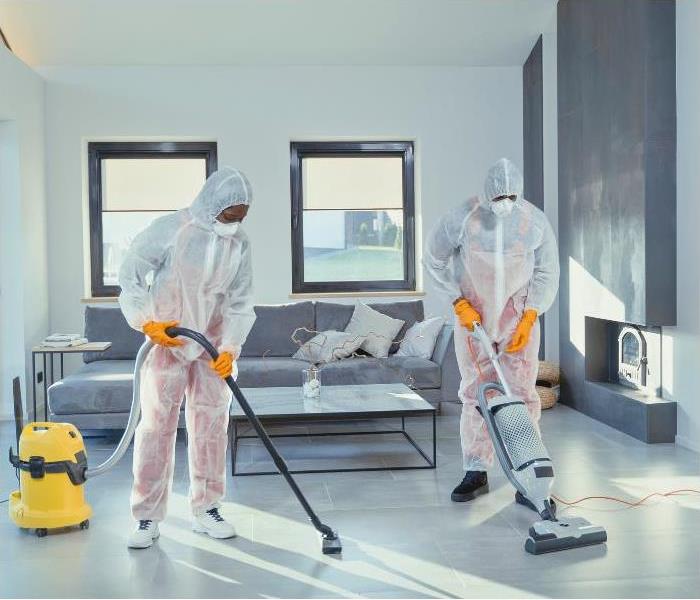 Storm Damage Restoration in Sandy, UT
Storm Damage Restoration in Sandy, UT
In the serene suburbs of Sandy, Utah, the tranquility of everyday life can sometimes be disrupted by the unpredictable forces of nature. From sudden thunderstorms to heavy snowfall, the residents of Sandy know all too well the impact that severe weather can have on their homes and communities. When disaster strikes, one company stands ready to restore hope and repair the damage: SERVPRO.
Understanding the Impact of Storm Damage
The aftermath of a storm can leave a trail of destruction in its wake. From flooded basements to damaged roofs and everything in between, storm damage can vary widely in its severity and scope. In Sandy, where the weather can change dramatically throughout the year, homeowners and businesses alike face the constant threat of wind, rain, and snow wreaking havoc on their properties.
Immediate Response and Assessment
SERVPRO's storm damage restoration process begins with a swift response. When a call comes in, their team mobilizes quickly to assess the situation and determine the necessary steps to mitigate further damage. In Sandy, where time is often of the essence due to the rapid onset of weather-related issues, this prompt response is crucial in preventing secondary damage such as mold growth or structural instability.
Upon arrival, SERVPRO technicians conduct a thorough inspection of the property. This assessment includes identifying areas that have been directly impacted by the storm, evaluating the extent of the damage, and developing a comprehensive restoration plan tailored to the specific needs of the property.
Water Extraction and Drying
One of the most common issues homeowners face after a storm is water damage. Whether it's from a burst pipe, a leaking roof, or flooding, excess water can quickly seep into walls, floors, and furniture, causing extensive damage if not promptly addressed.
SERVPRO utilizes state-of-the-art equipment for water extraction and drying. Powerful pumps and vacuums are employed to remove standing water swiftly and efficiently. Moisture meters and infrared cameras are used to detect hidden moisture pockets that could lead to future problems if left untreated. Once excess water has been removed, industrial-grade dehumidifiers and air movers are brought in to dry the affected areas thoroughly.
Restoration of Structural Damage
In cases where storms have caused structural damage, such as compromised roofs or weakened walls, SERVPRO's team of skilled professionals in Sandy are equipped to handle even the most challenging repairs. They work closely with local contractors and engineers to ensure that all repairs are completed to code and restore the structural integrity of the property.
From boarding up windows to tarping roofs, SERVPRO takes immediate action to secure the property and prevent further damage. Their goal is not only to restore the home or business to its pre-storm condition but also to provide peace of mind to property owners during the restoration process.
Cleaning and Content Restoration
Storm damage often leaves behind a trail of debris and contamination. SERVPRO's cleaning services extend beyond just removing visible dirt and debris. They employ specialized techniques and cleaning agents to sanitize and deodorize affected areas. Upholstery, carpets, and other belongings damaged by water or debris are carefully cleaned and restored whenever possible.
For items that require off-site restoration, SERVPRO offers pack-out services. This involves carefully packing and transporting belongings to a secure facility where they can be cleaned, dried, and restored using advanced techniques.
Community Support and Rebuilding Together
Beyond their technical expertise, SERVPRO is committed to supporting the Sandy community during times of crisis. They collaborate with local authorities, insurance companies, and community organizations to streamline the restoration process and ensure that homeowners and businesses receive the assistance they need promptly.
SERVPRO's involvement goes beyond restoring individual properties; they contribute to rebuilding the community as a whole. Whether through sponsoring local events or providing educational resources on disaster preparedness, SERVPRO strives to strengthen community resilience in Sandy and beyond.
In Sandy, Utah, where the beauty of nature meets the unpredictability of the weather, SERVPRO stands as a beacon of hope for homeowners and businesses facing the aftermath of storms. Through their meticulous storm damage restoration process, they not only repair physical damage but also restore peace of mind to those affected. From immediate response and assessment to comprehensive restoration and community support, SERVPRO's commitment to excellence shines through in every storm they encounter. When disaster strikes, Sandy residents can rest assured that SERVPRO will be there, ready to restore their homes and their lives.
7 Tips to Reduce Flooding Risks in Sandy, UT
5/17/2024 (Permalink)
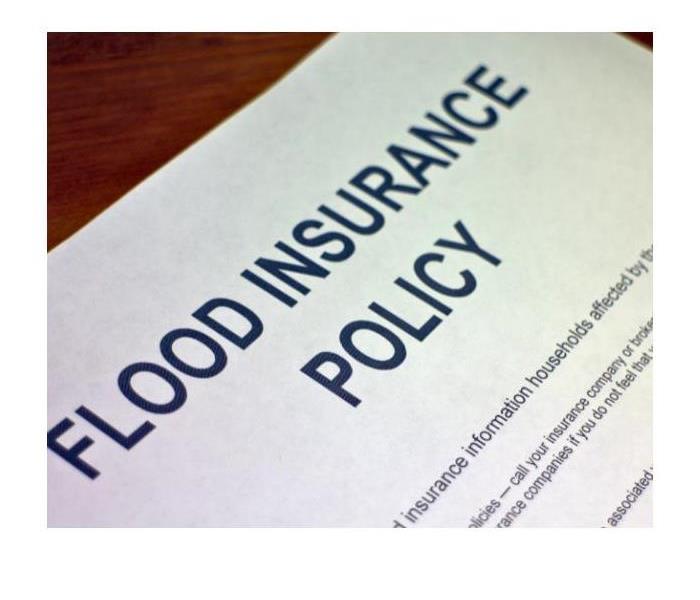 Mitigating Flood Risks in Sandy, UT
Mitigating Flood Risks in Sandy, UT
Sandy, Utah, nestled at the base of the picturesque Wasatch Mountains, is a vibrant community that offers its residents a high quality of life. However, like many areas, Sandy is not immune to the threats posed by flooding. With its proximity to the Jordan River and the potential for heavy rainfall and snowmelt, flooding can pose significant risks to both property and lives in this area. Fortunately, there are proactive steps residents can take to mitigate these risks and protect their homes and families. In this blog, we'll explore seven tips to reduce flooding risks in Sandy, UT.
1. Stay Informed: Knowledge is Power
One of the most crucial steps in preparing for flooding is to stay informed about potential risks and warning signs. Sandy residents should familiarize themselves with the local floodplain maps, which identify areas prone to flooding. Additionally, signing up for emergency alerts and notifications from the city or county can provide early warnings of impending flood events. By staying informed, residents can take proactive measures to protect themselves and their property.
2. Invest in Flood Insurance
Many homeowners mistakenly believe that their standard homeowner's insurance policy will cover flood damage. However, most policies do not include flood coverage, leaving homeowners vulnerable to significant financial losses in the event of a flood. To protect against this risk, residents in flood-prone areas like Sandy should consider purchasing flood insurance through the National Flood Insurance Program (NFIP). While it may require an additional investment, the peace of mind and financial protection it offers are invaluable.
3. Maintain Proper Drainage
Effective drainage is key to preventing flooding, so it's essential for homeowners to keep their drainage systems well-maintained. This includes regularly cleaning gutters and downspouts to ensure they are free of debris, as clogged gutters can cause water to overflow and pool around the foundation of a home. Additionally, homeowners should inspect their property for any signs of poor drainage, such as standing water or erosion, and take steps to address these issues promptly. Proper grading and the installation of French drains or other drainage solutions can help redirect water away from vulnerable areas.
4. Install Sump Pumps
For homes with basements or crawl spaces, installing a sump pump can be an effective way to mitigate flood risks. Sump pumps are designed to remove excess water that accumulates in these areas, helping to prevent water damage and mold growth. It's essential to regularly test and maintain sump pumps to ensure they are functioning correctly when needed most. Additionally, homeowners may want to consider installing a backup sump pump or a generator to provide power in the event of an outage during a flood.
5. Elevate Utilities and Appliances
Flooding can wreak havoc on electrical systems, heating and cooling equipment, and other appliances located in basements or low-lying areas. To minimize damage, homeowners should elevate these utilities and appliances above the potential flood level. This may involve relocating electrical panels, HVAC systems, water heaters, and other essential equipment to higher floors or installing them on raised platforms. Taking these precautions can help prevent costly damage and ensure that essential services remain operational during and after a flood.
6. Waterproof Your Home
Waterproofing measures can provide an additional layer of protection against flooding and water intrusion. This may include sealing cracks in the foundation, applying waterproof coatings to basement walls, and installing a perimeter drainage system or interior waterproofing membrane. Homeowners should also consider investing in flood-resistant building materials, such as flood barriers for doors and windows, to prevent water from entering their homes. While these measures may require an upfront investment, they can ultimately save homeowners thousands of dollars in repair costs.
7. Practice Emergency Preparedness
Despite our best efforts to prevent flooding, emergencies can still occur. That's why it's essential for Sandy residents to have an emergency preparedness plan in place. This plan should include evacuation routes, emergency contacts, and a stocked emergency kit with essentials such as water, non-perishable food, first aid supplies, and flashlights. Additionally, families should discuss and practice their plan regularly, so everyone knows what to do in the event of a flood or other disaster.
Flooding poses a significant risk to homeowners in Sandy, UT, but by taking proactive measures, residents can reduce their vulnerability and protect their homes and families. From staying informed and investing in flood insurance to maintaining proper drainage and practicing emergency preparedness, there are many steps homeowners can take to mitigate flooding risks. By implementing these tips, Sandy residents can navigate nature's fury with confidence and resilience.
Embrace the Spring Cleaning Season in Sandy, UT: A Fresh Start for Your Home
4/8/2024 (Permalink)
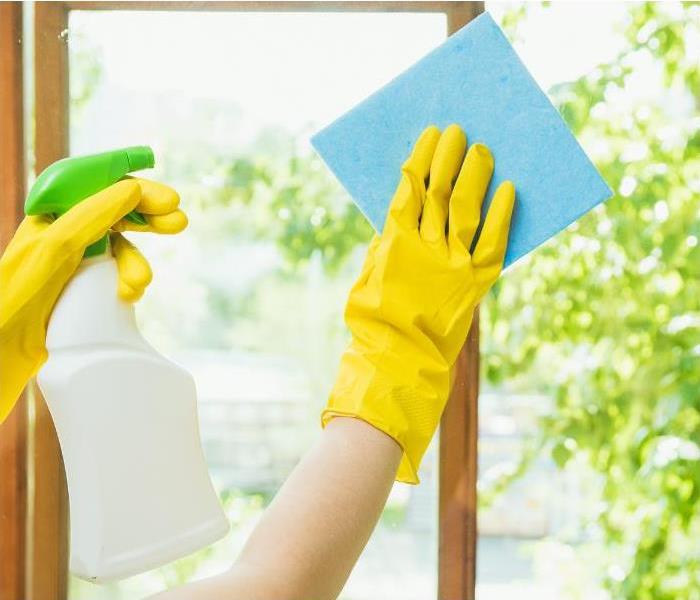 Spring cleaning in Sandy, UT.
Spring cleaning in Sandy, UT.
As the winter chill begins to thaw and the first signs of spring emerge, it's time to roll up your sleeves and embrace the age-old tradition of spring cleaning. Sandy, Utah, with its picturesque landscapes and vibrant community spirit, offers the perfect backdrop for this annual ritual of renewal. From decluttering your living spaces to refreshing your outdoor areas, here's how you can embark on a transformative spring cleaning journey in Sandy, UT.
1. Purge and Declutter
Spring cleaning begins with decluttering your home, and there's no better time to part ways with items you no longer need or use. Start with one room at a time, sorting through closets, cabinets, and drawers. Embrace the KonMari method by asking yourself if each item sparks joy. Donate gently used clothing, toys, and household goods to local charities or organize a yard sale to give your belongings a new lease on life.
2. Deep Clean Your Living Spaces
Once the clutter is out of the way, it's time to deep clean your living spaces. From dusting ceiling fans and baseboards to scrubbing floors and carpets, leave no corner untouched. Sandy, UT, is known for its stunning views of the Wasatch Mountains, so don't forget to clean your windows to let in as much natural light as possible. Consider using eco-friendly cleaning products to minimize your environmental impact while achieving a sparkling clean home.
3. Refresh Your Outdoor Areas
As the snow melts away and temperatures rise, take advantage of Sandy's beautiful outdoor spaces to spruce up your yard and garden. Clear debris, trim overgrown shrubs, and tidy up flower beds to create a welcoming outdoor oasis. Consider adding colorful flowers or planting a vegetable garden to add a touch of beauty and sustainability to your home. Don't forget to power wash your outdoor surfaces, such as patios and decks, to remove winter grime and prepare them for summer entertaining.
4. Organize and Streamline
Spring cleaning isn't just about cleaning—it's also about organizing and streamlining your belongings for maximum efficiency. Invest in storage solutions such as bins, baskets, and shelving units to keep clutter at bay and maintain a tidy home. Labeling storage containers can make it easier to find items when you need them, saving you time and frustration in the long run. Create designated spaces for frequently used items to prevent them from piling up on countertops or getting lost in drawers.
5. Tackle Maintenance Tasks
While spring cleaning is primarily focused on deep cleaning and organizing, it's also an opportunity to tackle essential maintenance tasks around your home. Check your HVAC system, replace air filters, and schedule a professional tune-up to ensure optimal performance during the warmer months. Inspect your plumbing for leaks, clean gutters and downspouts, and inspect your roof for any signs of damage. Addressing these tasks now can help prevent costly repairs down the road and keep your home in top condition.
6. Embrace Sustainable Practices
As you embark on your spring cleaning journey in Sandy, UT, consider incorporating sustainable practices into your routine. Use reusable cleaning cloths instead of disposable paper towels, switch to energy-efficient light bulbs, and recycle or repurpose items whenever possible. Composting organic waste can help reduce landfill waste while enriching your garden soil naturally. By adopting eco-friendly habits, you can minimize your carbon footprint and contribute to a cleaner, healthier planet for future generations.
7. Reward Yourself
Completing a thorough spring cleaning can be a rewarding experience, so don't forget to treat yourself for a job well done. Whether it's enjoying a leisurely hike in the nearby Wasatch Mountains, treating yourself to a delicious meal at a local restaurant, or simply relaxing with a good book in your freshly cleaned home, take time to savor the fruits of your labor. Spring cleaning is not just about achieving a clean and organized home—it's also about embracing a fresh start and welcoming the new season with open arms.
In conclusion, spring cleaning in Sandy, UT, is an opportunity to refresh your home, rejuvenate your spirit, and embrace the beauty of the season. By decluttering, deep cleaning, and organizing your living spaces, you can create a clean and inviting environment for yourself and your loved ones to enjoy. So, roll up your sleeves, grab your cleaning supplies, and embark on a transformative spring cleaning journey in Sandy, UT. Your home—and your soul—will thank you for it.
4 Facts About Black Mold in Sandy, UT
3/9/2024 (Permalink)
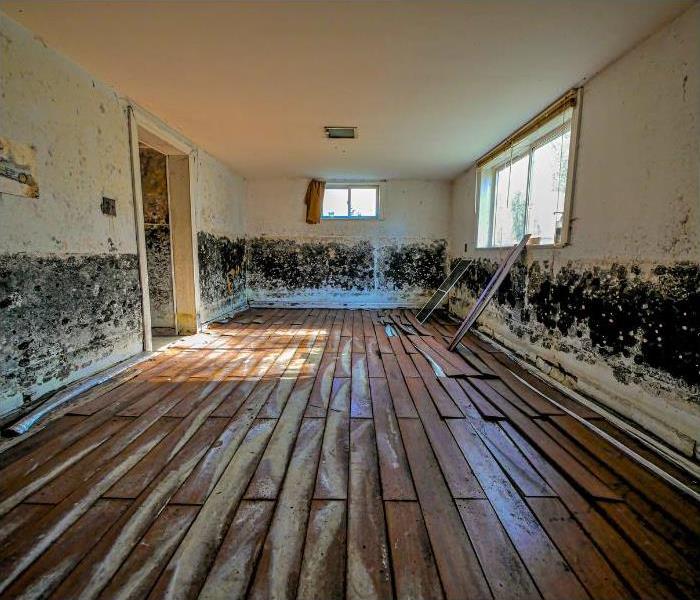 Black mold in Sandy, UT
Black mold in Sandy, UT
Nestled at the foothills of the stunning Wasatch Range, Sandy, Utah, boasts a picturesque landscape and a vibrant community. However, like any city, Sandy is not immune to the challenges posed by environmental factors, and one such concern is the presence of black mold. Black mold, scientifically known as Stachybotrys chartarum, is a type of toxic mold that can pose serious health risks to residents. In this blog post, we will explore four essential facts about black mold in Sandy, UT, shedding light on the potential dangers and the importance of addressing this issue promptly.
1. Ideal Conditions for Black Mold Growth
Understanding the conditions that foster black mold growth is crucial for residents in Sandy, UT, to take proactive measures. Black mold thrives in environments with high humidity and moisture levels. Sandy, with its semi-arid climate, may not seem like an ideal breeding ground for mold at first glance. However, specific indoor spaces, such as basements, bathrooms, and poorly ventilated areas, can create the perfect conditions for mold growth.
Sandy residents should be particularly vigilant during the winter months when temperature fluctuations, coupled with inadequate insulation and ventilation, can lead to condensation issues. Water damage from leaks, floods, or plumbing problems can also contribute to the growth of black mold. Regular inspections and maintenance of homes and buildings can help prevent the conditions that encourage mold development.
2. Identification and Prevention Strategies
Recognizing the signs of black mold infestation is crucial for prompt intervention. Mold often appears as dark, slimy patches on walls, ceilings, or other surfaces. A musty odor is another indicator of mold growth, and residents in Sandy should be attentive to any unusual smells in their homes. Discoloration, water stains, or peeling paint may also suggest a moisture problem that could lead to mold development.
Preventing black mold in Sandy, UT, involves implementing practical strategies to control moisture levels. Proper ventilation, dehumidifiers, and routine inspections can help maintain optimal indoor conditions. Additionally, addressing water leaks or flooding promptly is essential to prevent the growth of mold. Homeowners should also consider using mold-resistant materials in construction and keeping living spaces well-maintained to discourage mold colonization.
3. Professional Mold Remediation Services
While proactive prevention is crucial, situations may arise where black mold has already infiltrated a home or building. In such cases, it is imperative to seek professional mold remediation services to effectively address the issue. Attempting to handle mold removal without the necessary expertise and equipment can exacerbate the problem and pose health risks.
Sandy residents should engage certified mold remediation professionals who follow industry best practices and safety protocols. These experts can conduct thorough inspections, assess the extent of the mold infestation, and develop a comprehensive remediation plan. Specialized equipment, such as HEPA filters and containment barriers, is used to ensure the safe removal of mold without spreading spores to unaffected areas.
In conclusion, understanding the facts about black mold in Sandy, UT, is essential for residents to protect their homes and health. By being aware of the ideal conditions for mold growth, recognizing health implications, implementing prevention strategies, and seeking professional remediation when necessary, Sandy residents can create a safer and healthier living environment. Regular maintenance, prompt attention to water issues, and a proactive approach to mold prevention will contribute to a community that thrives in the face of potential challenges posed by black mold.
Swift Solutions to Water Damage: SERVPRO of Sandy to the Rescue
1/13/2024 (Permalink)
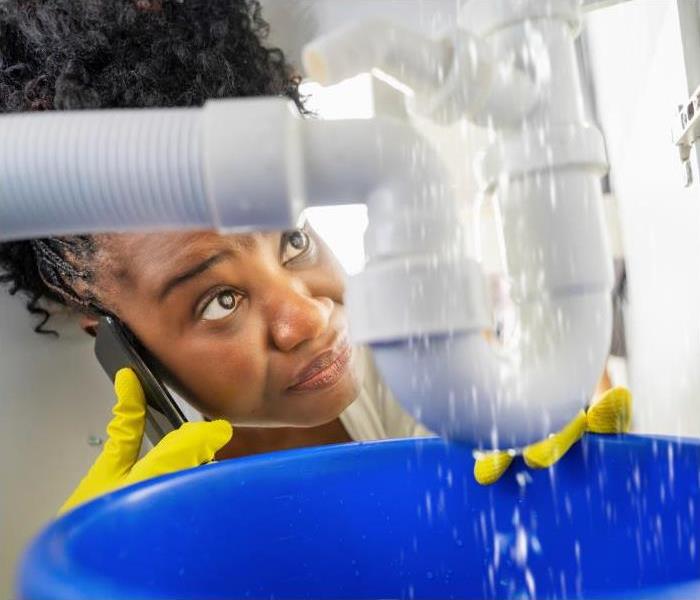 Leaking pipe in Sandy, Salt Lake City, Utah.
Leaking pipe in Sandy, Salt Lake City, Utah.
Water damage can strike at any moment, catching homeowners off guard and wreaking havoc on their property. One of the most common causes of water damage is a leaking pipe. Whether it's a slow and persistent drip or a sudden burst, the consequences can be devastating. However, acting swiftly is crucial to mitigating the damage and preventing long-term issues. In such situations, SERVPRO of Sandy emerges as a beacon of hope, providing immediate and effective solutions to address water damage caused by leaking pipes.
1. Understanding the Scope of Water Damage:
Before delving into the role of SERVPRO of Sandy, it's essential to comprehend the potential consequences of water damage stemming from a leaking pipe. Aside from obvious property damage, water intrusion can lead to mold growth, compromised structural integrity, and health hazards. It's a race against time to mitigate these risks, emphasizing the need for prompt action.
2. Immediate Response: The SERVPRO Advantage
SERVPRO of Sandy specializes in professional water damage restoration, offering a swift and comprehensive response to mitigate the effects of water damage. Their team of highly trained technicians understands the urgency of the situation and is equipped with the latest tools and technology to address the issue promptly.
3. Emergency Water Extraction:
The first step in the mitigation process is the extraction of standing water. SERVPRO of Sandy employs advanced water extraction equipment to swiftly remove water from the affected areas. This not only prevents further damage but also expedites the drying process.
4. Thorough Drying:
Once standing water is removed, the focus shifts to thorough drying of the affected spaces. SERVPRO utilizes industrial-strength dehumidifiers and high-powered air movers to eliminate moisture from walls, floors, and other surfaces. This prevents the onset of mold and mildew, safeguarding the indoor air quality.
5. Professional Assessment:
A crucial aspect of SERVPRO's service is a professional assessment of the extent of water damage. This assessment guides the restoration process, ensuring that no hidden pockets of moisture are left untreated. Their experts use moisture meters and thermal imaging technology to identify areas that may require special attention.
6. Mold Remediation:
Given enough time and moisture, mold can quickly become a secondary concern. SERVPRO of Sandy is well-versed in mold remediation techniques, addressing any mold growth resulting from the water damage. Timely intervention in this regard can prevent more significant issues down the line.
7. Structural Restoration:
In cases of severe water damage, structural components of a property may be compromised. SERVPRO of Sandy has the expertise and resources to handle structural restoration, ensuring that the property is returned to its pre-damage condition.
8. Content Restoration:
Water damage doesn't only affect the structure but also the contents within. SERVPRO employs specialized techniques for content restoration, salvaging belongings that may have otherwise been deemed unsalvageable.
9. Customer-Centric Approach:
SERVPRO of Sandy takes a customer-centric approach to water damage restoration. They understand the stress and disruption such events can cause, and their team is committed to providing compassionate and efficient service. Their communication is transparent, keeping homeowners informed at every step of the restoration process.
10. 24/7 Availability:
Water damage doesn't adhere to a schedule, and neither does SERVPRO of Sandy. Their emergency response team is available 24/7, ready to spring into action whenever disaster strikes. This prompt response can make all the difference in minimizing damage.
11. Insurance Coordination:
Navigating insurance claims can be a daunting task, especially in the aftermath of a crisis. SERVPRO of Sandy assists homeowners in the claims process, working with insurance companies to ensure a smooth and efficient resolution.
12. Preventive Guidance:
Beyond the immediate restoration, SERVPRO of Sandy offers preventive guidance to homeowners. This includes recommendations on how to safeguard against future water damage, whether through routine maintenance or the installation of protective measures.
Dealing with water damage resulting from a leaking pipe requires immediate and professional intervention. SERVPRO of Sandy stands out as a reliable partner in these challenging times, offering a swift and comprehensive response to mitigate the effects of water damage. Their expert team, advanced technology, and customer-centric approach make them a beacon of hope for homeowners facing the unexpected aftermath of a leaking pipe. When water damage strikes, SERVPRO of Sandy is the trusted ally to restore homes and peace of mind.
A Guide to Dealing with Frozen Pipes in Sandy, UT
12/27/2023 (Permalink)
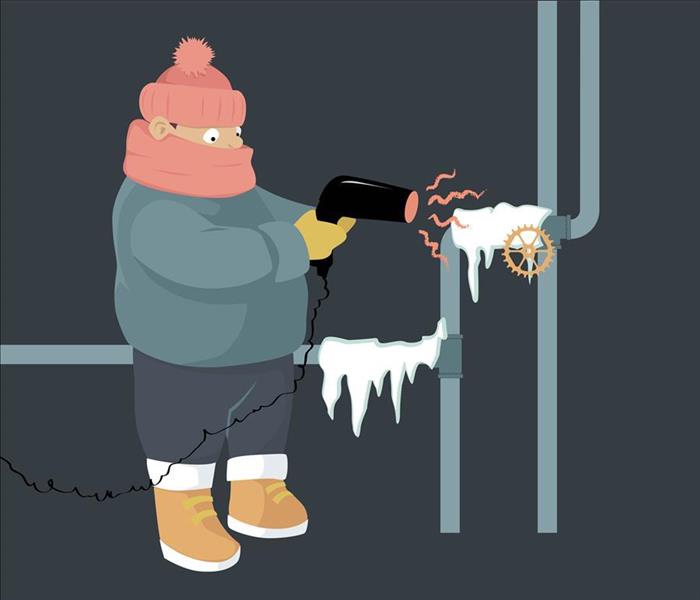 Frozen pipes in Sandy, UT.
Frozen pipes in Sandy, UT.
Sandy, UT, with its breathtaking landscapes and serene winters, is a haven for those who appreciate the beauty of the season. However, as temperatures drop, residents are faced with the challenge of protecting their homes from the harsh effects of winter, including the dreaded issue of frozen pipes. In this comprehensive blog post, we will delve deeper into the nuances of dealing with frozen pipes in Sandy and explore a range of preventative measures and practical tips to help you navigate this winter woe effectively.
Understanding the Enemy:
Before we dive into the solutions, it's crucial to understand why pipes freeze and the potential consequences. When temperatures plummet, water inside pipes can freeze, causing them to expand. This expansion can lead to a build-up of pressure within the pipes, risking cracks or even bursts. The consequences are not only inconvenient but can result in costly repairs and water damage to your property.
Preventative Measures:
Insulation is Your Ally: The first line of defense against frozen pipes is proper insulation. Identify exposed pipes in your home, particularly those in unheated or exterior areas, and insulate them using pipe sleeves or heat tape. By adding an extra layer of protection, you create a barrier that helps retain the heat within the pipes, preventing them from freezing.
Seal the Gaps: Cold drafts can find their way into your home through gaps around doors and windows. Inspect these areas and seal any openings to prevent the intrusion of frigid air. Weatherstripping and caulking are effective tools in fortifying your home against the winter chill.
Keep the Heat On: It may be tempting to turn down the thermostat to save on energy costs, especially when you're away. However, maintaining a consistent indoor temperature is crucial in preventing frozen pipes. Set your thermostat to a level that keeps your home comfortably warm, even when you're not there. This steady warmth provides a vital layer of protection for your plumbing.
Let the Faucets Drip: On exceptionally cold nights, allowing faucets connected to vulnerable pipes to drip slowly can be a game-changer. The movement of water, even at a minimal flow, helps prevent it from stagnating and freezing within the pipes. This simple yet effective technique is particularly useful during extreme cold spells.
Cabinet Doors Open: In areas where plumbing is located inside cabinets, such as under sinks, consider opening the cabinet doors during cold weather. This allows warm air to circulate around the pipes, reducing the chances of them freezing. It's a small adjustment that can make a significant difference in maintaining the warmth needed to prevent freezing.
Thawing Frozen Pipes:
Despite your best efforts, frozen pipes may still occur. When faced with this situation, it's essential to know how to thaw them safely to avoid causing further damage.
Locate the Frozen Section: If you suspect a pipe is frozen, the first step is to identify the affected area. This may involve checking exposed pipes in unheated areas, such as basements, crawl spaces, or attics.
Apply Gentle Heat: Once the frozen section is identified, the next step is to apply gentle heat. This can be achieved using a hairdryer, heat lamp, or towels soaked in hot water. It's crucial to start at the end closest to the faucet to allow water to flow out as the ice melts.
Avoid Open Flames: While heat is essential for thawing pipes, it's crucial to avoid using open flames or high-intensity heat sources. These can damage the pipes and pose a significant safety risk. Stick to safer alternatives such as electric heating tools designed for this purpose.
Patience is Key: Thawing frozen pipes requires patience. Rushing the process can lead to complications. Allow the heat to work gradually, and monitor the thawing progress to ensure a steady and controlled resolution.
When to Seek Professional Assistance:
While many instances of frozen pipes can be handled with the tips mentioned above, there are situations where professional assistance is warranted.
Persistent Issues: If you find yourself dealing with persistent issues of frozen pipes despite taking preventive measures, it's time to consult a licensed plumber. A professional can conduct a thorough assessment of your plumbing system, identify any underlying problems, and implement effective solutions.
Uncertain Situations: If you're unsure about how to handle frozen pipes or suspect more extensive damage, it's best to err on the side of caution and seek professional help. Ignoring potential issues can lead to further damage and increased repair costs.
As winter settles into Sandy, UT, the idyllic landscapes may be accompanied by the challenges of frozen pipes. However, armed with the knowledge of preventative measures, effective thawing techniques, and the wisdom to seek professional help when needed, residents can confidently face the winter season. Remember, the key lies in preparation and a proactive approach. By taking these steps, you not only protect your home from the inconvenience of frozen pipes but also ensure a cozy and worry-free winter. Stay warm, stay informed, and let the beauty of winter in Sandy be a source of joy, not plumbing headaches.
Winterizing Your Home in Sandy, Utah: A Comprehensive Guide to Protecting Your Investment
11/9/2023 (Permalink)
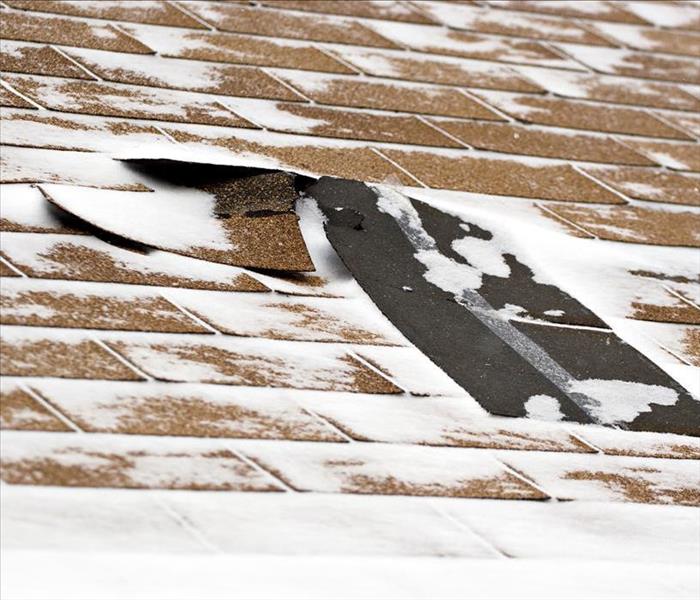 Inspect and repair your roof now to avoid damage during winter season in Sandy, UT.
Inspect and repair your roof now to avoid damage during winter season in Sandy, UT.
Winter in Sandy, Utah, with its picturesque snow-covered landscapes and crisp air, brings a unique charm to the region. However, the beauty of the season also comes with challenges for homeowners, as the cold temperatures and winter storms can pose risks to property and infrastructure. To ensure your home stays warm, cozy, and damage-free throughout the winter season, here's a detailed guide on how to prepare for winter in Sandy, Utah.
10 Steps To Prepare Your Home For Winter
1. Sealing the Envelope: Inspect and Seal Windows and Doors
One of the first steps in winter preparation is to inspect your home's envelope for potential drafts. Cold air seeping in through gaps around windows and doors can significantly impact your home's energy efficiency. Conduct a thorough examination, checking for any cracks, gaps, or leaks. Seal these openings with weatherstripping or caulking to create a tighter seal, preventing cold air from entering and warm air from escaping. This simple yet effective measure not only keeps your home warmer but also helps reduce energy costs during the winter months.
2. Gutter Maintenance: Cleaning and Inspection
Proper gutter maintenance is essential to prevent water-related issues during winter. Clogged gutters can lead to ice dams, causing water to back up and potentially damage your roof and interior. Before winter arrives, clean out any debris from gutters and downspouts. Ensure that water can flow freely to prevent ice buildup. Consider installing gutter guards to minimize debris accumulation, reducing the frequency of cleanings. This proactive approach to gutter maintenance will safeguard your home from the potential hazards of ice dams and water damage.
3. Protecting Your Pipes: Insulation and Prevention
Frozen pipes can result in extensive damage and costly repairs. To prevent this winter nightmare, insulate exposed pipes in areas such as attics, basements, and crawl spaces. Use pipe insulation sleeves or heat tape to provide an extra layer of protection. During extremely cold nights, let faucets drip to keep water flowing, reducing the risk of freezing. Familiarize yourself with the location of your water shut-off valve, as knowing how to quickly turn off the water supply can mitigate potential damage in case of a pipe burst. Taking these measures ensures that your plumbing remains intact and functional throughout the winter.
4. Heating System Maintenance: Schedule a Professional Inspection
A reliable heating system is paramount for a comfortable and safe winter. Schedule a professional inspection of your furnace before the cold sets in. A qualified technician can identify and address any issues, ensuring that your heating system operates efficiently throughout the winter months. Regular maintenance not only enhances performance but also reduces the risk of unexpected breakdowns. Additionally, changing the furnace filter and checking the thermostat settings contribute to a more energy-efficient and cost-effective heating system.
5. Winterizing Outdoor Plumbing: Preventing Frozen Pipes
Outdoor plumbing, such as hoses and water valves, requires special attention before winter arrives. Disconnect and drain outdoor hoses to prevent freezing, as frozen water in hoses can lead to pipe damage. Shut off outdoor water valves and drain any remaining water to eliminate the risk of frozen pipes. By winterizing your outdoor plumbing, you safeguard these vulnerable components from the effects of cold temperatures, reducing the likelihood of burst pipes and water damage.
6. Roof Integrity: Inspect and Repair
Your roof is the first line of defense against winter weather. Inspect it for any damaged or missing shingles, as these vulnerabilities can lead to leaks and water damage. Snow and ice can exacerbate existing issues, making proactive roof maintenance crucial. Address any identified problems promptly to ensure your roof remains in top condition throughout the winter season. Investing time in roof inspection and repair now can save you from more extensive and costly repairs in the future.
7. Stock Up on Winter Supplies: Essentials for Snowy Days
Being prepared for winter storms is essential for maintaining both safety and comfort. Stock up on winter supplies, including rock salt, sand, and snow shovels. These items are crucial for quickly clearing walkways and driveways after snowfall, minimizing the risk of slips and falls. Keep these supplies easily accessible, and consider creating a designated storage area for winter essentials. Proactive preparation ensures that you're ready to tackle winter weather challenges and maintain a safe and navigable outdoor space around your property.
8. Pruning and Trimming: Protecting Against Winter Weight
Heavy snow and ice can weigh down tree branches, posing a risk to your home and property. Prune trees and trim branches, especially those close to your house. This preventive measure reduces the likelihood of branches breaking under the weight of winter precipitation. By addressing potential hazards before winter storms hit, you minimize the risk of damage to your roof, windows, and other structures. Regular tree maintenance not only protects your property but also contributes to the overall safety and aesthetics of your outdoor space.
9. Create an Emergency Kit: Preparedness for Unexpected Events
Winter weather can bring unexpected challenges, from power outages to impassable roads. Prepare for such scenarios by assembling an emergency kit. Include items such as flashlights, batteries, blankets, non-perishable food, and a first aid kit. Having these essentials on hand ensures that you're ready to face unexpected situations with confidence. Regularly check and update your emergency kit to ensure that all items are in good condition and within their expiration dates. Being well-prepared allows you to navigate winter storms with resilience and ensures the safety and well-being of your household.
10. Stay Informed: Weather Awareness for Proactive Planning
Knowledge is a powerful tool in winter preparedness. Stay informed about local weather forecasts, advisories, and warnings. Regularly check reliable weather sources to stay ahead of upcoming storms and extreme weather events. Being aware of potential challenges allows you to take necessary precautions, plan accordingly, and respond effectively to changing conditions. Whether it's adjusting your schedule to avoid hazardous travel times or taking additional precautions around the home, staying informed is a key component of a comprehensive winter preparedness strategy.
In conclusion, preparing your home for winter in Sandy, Utah involves a combination of proactive measures and regular maintenance. By sealing your home's envelope, maintaining gutters, protecting pipes, servicing your heating system, winterizing outdoor plumbing, inspecting your roof, stocking up on winter supplies, pruning trees, creating an emergency kit, and staying informed about weather conditions, you can safeguard your investment and ensure a comfortable and worry-free winter season. Taking these steps not only protects your property but also contributes to the overall safety and well-being of your household during the winter months. Stay warm, stay safe, and embrace the beauty of winter in Sandy, Utah.
Cooking Up Safety: Protecting Your Kitchen from Fires and Restoring Your Home with SERVPRO of Sandy
10/19/2023 (Permalink)
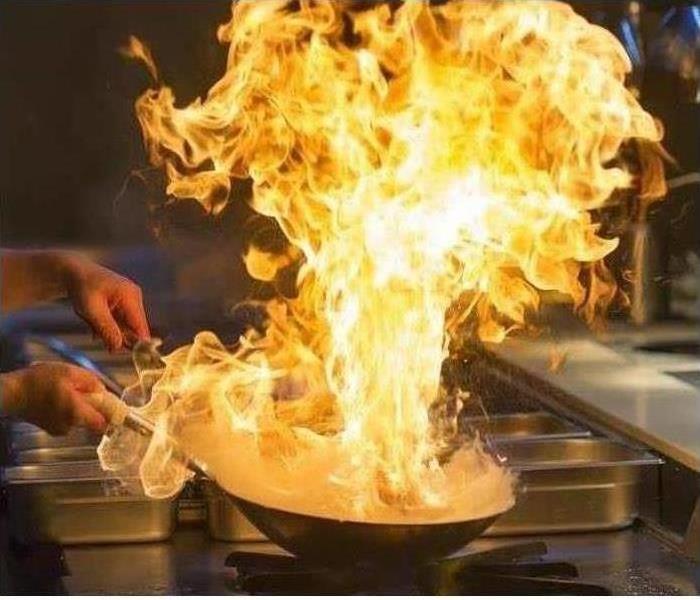 Kitchen fires can be devastating to your Sandy, UT, home.
Kitchen fires can be devastating to your Sandy, UT, home.
The kitchen, often dubbed the heart of the home, is a place where we create culinary masterpieces, bond with family, and make cherished memories. But it's also a potential hotbed for fires. Ensuring your kitchen is safe from fires is not only a matter of personal safety but also one of safeguarding your most treasured space. In this comprehensive blog post, we'll delve deep into the topic of kitchen fire prevention and introduce you to the indispensable services offered by SERVPRO of Sandy when disaster strikes.
Fire Prevention in the Kitchen
The Leading Causes of Kitchen Fires
Unattended Cooking: Among the most common causes, unattended cooking tops the list. Leaving your stove or oven unattended is a recipe for disaster.
Grease Fires: The combination of oil, high heat, and an open flame can quickly escalate into a dangerous grease fire.
Electrical Failures: Faulty wiring, worn-out appliances, or misuse of kitchen electricals can spark electrical fires.
Cluttered Workspaces: Piles of paper towels, dishtowels, and clutter near the stovetop or oven can easily ignite.
Preventive Measures for a Fire-Safe Kitchen
Never Leave the Stove Unattended: Commit to staying in the kitchen while cooking, or have someone responsible take your place.
Keep Flammables at Bay: Store dishcloths, potholders, and paper towels away from the stove and other heat sources.
Regular Appliance Maintenance: Ensure your kitchen appliances are in top-notch condition. Faulty wiring or malfunctioning appliances can trigger fires.
Smoke Detectors: Equip your home, particularly the kitchen, with working smoke detectors, and test them regularly.
Fire Extinguishers - Your Kitchen's Firefighter
In any firefighting effort, a fire extinguisher is your first line of defense. Having one at your fingertips can make all the difference in containing a fire before it grows out of control. Here are some key points to consider:
Choosing the Right Extinguisher: Different types of fire extinguishers are designed to combat different classes of fires. Familiarize yourself with the types and have the appropriate one for your kitchen.
Proper Usage: Owning a fire extinguisher is not enough; you must know how to use it. Train yourself and family members on its operation.
SERVPRO of Sandy - Your Restoration Partner
Sometimes, despite your best efforts, fires do occur. In such trying moments, SERVPRO of Sandy is your trusted partner in restoring your home. Here's how they can assist:
24/7 Emergency Response:
Fires can strike at any hour. SERVPRO of Sandy understands this and offers 24/7 emergency response. Their swift action helps minimize the damage.
Assessment and Cleanup:
Post-fire, your home may be left in shambles. SERVPRO professionals assess the situation, remove debris, and meticulously clean the affected areas to prepare for restoration.
Odor Removal:
Smoke and fire residues leave behind stubborn, unpleasant odors. SERVPRO employs advanced techniques to eliminate these odors, leaving your home smelling fresh once again.
Restoration and Reconstruction:
SERVPRO of Sandy doesn't stop at cleanup. They specialize in restoration and reconstruction, restoring your home to its pre-fire condition. From repairing damaged walls to replacing flooring and fixtures, they ensure your kitchen and the rest of your home looks as good as new.
In conclusion, preventing kitchen fires in your Sandy, UT, home is of paramount importance. It's a testament to your commitment to safety, not just for yourself but for your family and your home. Staying vigilant, maintaining your kitchen appliances, and having the right safety equipment on hand are fundamental steps in minimizing the risk of kitchen fires.
Should the unexpected occur, however, rest assured that SERVPRO of Sandy is here to help you recover and rebuild. Your kitchen will once again become the place of joy, warmth, and cherished memories that it should be.
Remember, fire safety in the kitchen is not just about preventing fires but also being prepared for their aftermath. A well-protected and restored kitchen is not just a source of sustenance but a source of comfort and happiness in your home. Stay safe and enjoy your culinary adventures in a secure and welcoming environment.
How To Protect Your Home After Fire Damage
9/13/2023 (Permalink)
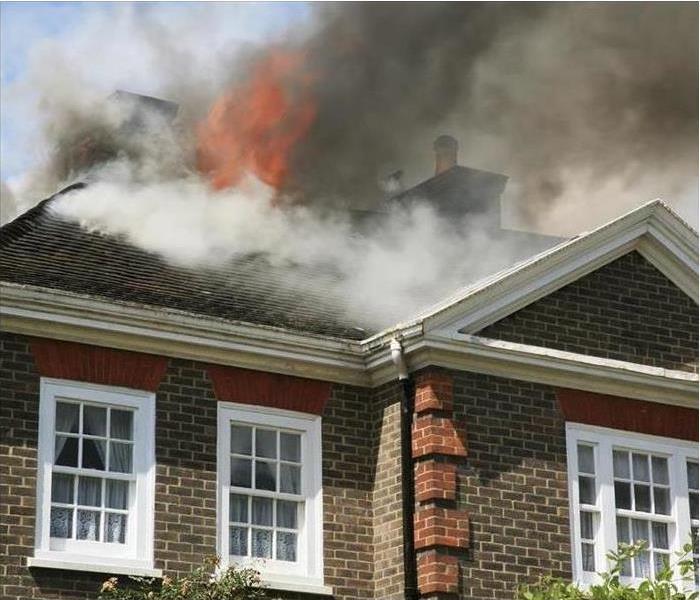 Fire damage in Sandy, UT.
Fire damage in Sandy, UT.
Whether you are waiting on the insurance company or the contractor, it can take a while for repairs to be completed on a fire-damaged home. Protective steps, such as board up service, can prevent additional damage from occurring to your home while you wait.
Emergency Board Up Service
If your home has extensive fire damage, you may be tempted to think it couldn't possibly get any worse. However bad the damage may seem, there are several reasons you should protect your property:
- Theft or Vandalism
Vacant homes are attractive targets for thieves and vandals because the risk of being caught is lower. Burned homes may contain valuable property that thieves may steal if your home is not properly protected.
- Insurance Requirements
Most insurance policies require homeowners to take reasonable steps to prevent additional damage from occurring to their homes. Failing to take these steps may result in additional damage not being covered by your insurance. Fortunately, most insurance covers the cost of these protective measures.
- Liability
If you don't secure your damaged home and someone goes inside and gets hurt, you may be liable for that person's injuries. However, you should not enter an unsafe building yourself. You may need to contact a professional restoration service in Sandy, UT, to safely secure your property.
- Weather and Animals
Holes in the roof and walls of your home provide entry points for wind, water and animals. Covering up these openings prevents additional damage from occurring because of a storm or animal infestation.
What Is Board Up Service?
The heat from a fire can cause windows to break. Additionally, windows are often targets for vandals or thieves. Windows can be secured by covering the openings with plywood and securing them with bolts attached to the interior walls. Plywood may also be used to cover sections of the exterior walls or roof that have holes.
What Is Tarping?
Tarps may be used to cover damaged portions of your roof to prevent rain from entering your home. Because working on a fire-damaged roof can be dangerous, it is a good idea to contact a professional to provide this service.
What Other Steps Should I Take?
The water used to put out fires can cause additional damage if steps are not taken to dry out your home as soon as possible. Do not attempt to enter your home until the fire department says it is safe. Once you can go inside, start removing wet items. Consider contacting a restoration service to assist with drying out your home.
Do not attempt to move back into your home until all of the fire and smoke damage has been cleaned up. If you have insurance, your insurance policy may pay for you to temporarily live somewhere else, such as a hotel room or a rental, while your home is being cleaned and repaired.
Protective steps, such as board up service, can prevent additional damage to your home. Your insurance professional or local fire department can assist you if you are unsure which steps to take to secure your property.



 24/7 Emergency Service
24/7 Emergency Service









